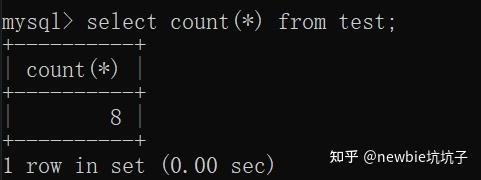|
|
1.安装和测试
参考:windows10上安装mysql(详细步骤)_他们叫我周周周的博客-CSDN博客_mysql安装
2.操作数据库
- 连接数据库:mysql -u 用户名 -p + 回车键 再输入密码
- 退出数据库:exit或者quit
- 查看已经有的数据库:show databases;(记得有s)
- 查看数据库版本:select version(); (SQL语句分号不能少)
- 创建数据库:
- create database 数据库名称;(如:create databases test; 创建一个叫做test的数据库)
- create database 数据库名称 charset = utf8;(指定编码为utf8)
- 查看数据库创建的命令:show create database 数据库名称;(比如:show create database test;)

- 查看当前使用的数据库:select database(); 括号不能忘记。
- 使用数据库:use 数据库名称;(比如:use test;)
- 删除数据库:drop database 数据库名称;(比如:drop database test2;)
3.操作数据表
- 查看当前库中所有表:show tables;
- 创建表:create table 表明(字段名 类型 约束);比如(create table test(age int);)
- 查看表的创建语句:show create table 数据表名;(show create table test;)
- 查看表描述信息:describe 数据表名; (describe test;)
- 添加表字段:alter table 数据表名称 add 字段名称 字段类型;(alter table test add salary double;)
- 修改表字段类型
- 不重新命名 alter table 数据表名称 modify 字段 新的字段类型;(alter table test modify salary int;)
- 重新命名 alter table 数据表名称 change 旧字段名 新字段名 新数据类型;(alter table test change height h int;)将原来的字段height修改为h同时数据类型为int。
- 删除表字段:alter table 数据表名称 drop 字段;(alter table test drop h;)
4.操作数据
1.新增修改删除数据
- 整行插入:insert into 表名 values(?, ?, ?, ...)所有列都要加
- 指定列中插入数据:insert into 表名(指定的列) values(指定列对应的数据)
- insert into test(age, salary) values(24, 22059.02);
- 指定列中插入多条数据:insert into 表名(指定列) values(对应的值1), (对应的值2),(对应的值3);
- insert into test(age, salary) values(28, 30129.29), (32, 42139.08);
- 修改数据:update 数据表名 set 字段 = 新值 where 字段 = 某个值
- update set test salary = 22896.07 where age = 24;
- 删除数据:delete from 数据表名称 where 字段 = 某个值;
- delete from test where age = 18;
2.查询数据
- 查询整个表数据:select * from 表名;(select * from test;)
- 查询指定字段数据:select 字段1,字段2,字段n from test;(select age from test;)
- 查询指定字段数据,并给字段起别名:select 字段1 as 别名1, 字段2 as 别名2 from 数据表名
- select age as a, salary as s from test; select age as a from test;
- 查询指定字段并去重:select distinct 字段1,字段2,字段n from 数据表名称;
- 如果是多个字段一起去重那要全部一样才行,不然就不会去重。
- select distince age from test; select distinct age, salary from test;
- where子句:用于做筛选条件
- 比如age=18的时候的数据select * from test where age = 18;
- where子句还可以结合运算符一起使用
- 比较运算符:=、>、>=、<、<=、<>(这个是不等于)、逻辑运算符:and、or、not a(不是a)
- select * from test where age >= 20;
- select * from test where age <> 20;
- 模糊查询:like + % / _:%表示任意多个字符,_表示任意一个字符。
- select * from test where age like &#34;%&#34;; %表示多个字符
- select * from test where age like &#34;_5&#34;; _表示一个字符 后面那个字符必须是5
- 范围查询:两个关键字 一个是in(非连续),一个是between...and...(连续范围)
- in:表示在一个离散取值的范围内。
- select * from test where age in (18, 20, 22);表示选取test表中年龄等于18 20 22这三的数据
- select * from test where age not in (18, 20, 22);
- between...and:表示在一个连续范围内。
- select * from test where age between 20 and 27;选在20-27范围内的数据
- select * from test where age (between 20 and 27) and sex = 1;
5.聚合函数
- count:总数
- 查询表中一共有多少条数据:select count(*) from test;

- 查询表中某一种数据的总数:比如查年龄大于等于25的总人数
- select count(*) from test where age >= 25;

- max():最大值
- 比如查询最大的年龄:select max(age) from test;
- min():最小值
- 比如查询薪资的最小值:select min(salary) from test;
- sum():求和
- 查询所有薪资的和:select sum(salary) from test;
- avg():平均值
- 查询平均薪资:select avg(salary) from test;
6.分组筛选
通过group by 将查询结果按照1个或者多个字段进行分组,字段相同的为一组。比如按照班级进行group by,一个班级的在一个组。
select *(字段名) from 数据表名称 group by 需要分组的字段名;
分组后的筛选:原始数据集根据where以后得到结果集1;结果集1再根据group by得到结果集2;结果集2再根据having得到结果集3。having是group by以后用来筛选的。
待补充...
7.排序
- order by 字段 默认升序
- order by asc 字段 指定升序
- order by desc 字段 指定降序
待补充...
8.限制
- 语法:limit start, count
- start:偏移量,默认为0
- count:要选出来的条数
- 注意点:limit只能写在最后面
9.表连接
内连接+外连接。外连接 = 左 + 右连接
1.内连接
- 仅选出两张表中互相匹配的记录,公共的数据。A表B表都有的。
- select * from 表1 inner join 表2 on 表1.列 = 表2.列;
- select * from train inner join test on train.age = test.age;
2.左连接
- 左表有的数据,如果右表没有的话就用null填充。
- select * from 表1 left join 表2 on 表1.列 = 表2.列;
- select * from train left join test on train.age = test.age;
3.右连接
- 右表有的数据,如果左表中不存在就用null填充。
- select * from 表1 right join 表2 on 表1.列 = 表2.列;
10.子查询
待补充...
参考链接:
Sql语句 · 语雀 |
|